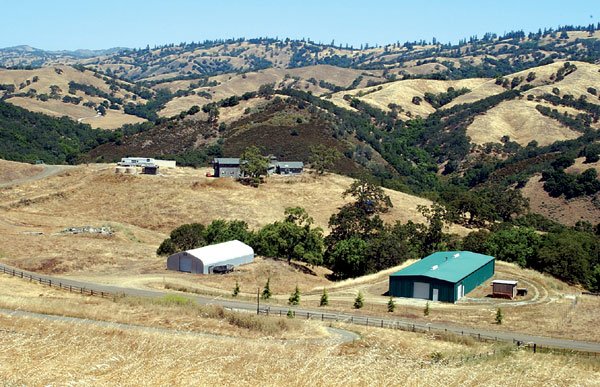Property meets any reasonable definition of open space, but
isn’t large enough to qualify for the tax break
Gilroy – Already at the top of South County, John Gormley is fighting an uphill battle to keep his neighborhood in the Williamson Act.
Gormley lives atop Finley Ridge, in a speck of a house far above Lake Anderson, on a 20-acre lot that proves just how hard it’s going to be enforce the rules of the act and live up to its spirit.
The Williamson Act is supposed to protect farmland and open space. It does so through a complicated set of rules governing land use, location and lot size that Santa Clara County officials have had difficulty understanding and managing. Now that the county is poised to evict non-compliant parcels next year, Gormley is one of many property owners who feel caught in the middle, established on a property that meets any reasonable definition of open space, but isn’t large enough to qualify for the Williamson Act’s generous tax break.
“It’s going to get ugly,” Gormley said recently. “You and I know there are a lot of properties that need to come out of the Williamson Act, but we’re a big agricultural preserve up here.”
Gormley is one of 38 owners of the Lake Anderson Ranchos. About half of the parcels are bare; the other half developed with modest homes. Until about two years ago, the owners had a mutual cattle grazing lease on their contiguous 720 acres. About the same time, the lease expired, the county was slapped with a scathing report criticizing its enforcement of the act after a California Department of Conservation audit found as many as 1,200 parcels that didn’t belong.
Under Williamson rules, prime lots, usually valley floor plots of row crops and orchards, must be at least 10 acres. Non-prime lots such as hillside grazing parcels need be at least 40 acres. Before it was subdivided three decades ago, the Lake Anderson Ranchos easily qualified for the act’s tax relief. But taken one at a time, the parcels don’t meet the size requirements and aren’t big enough to meet the county’s interim guideline of $2,000 in annual agriculture income.
“Individual parcels up there are not going to meet the definition of commercial agriculture, but I’m more than happy to be proved wrong,” said Kevin O’Day, the county’s deputy agriculture commissioner.
When a property owners wishes to get into the act, or when an existing contract holder wants to build a new house, it’s O’Day’s job to verify that the property can sustain a viable commercial farm venture. He said that even if the Finley Ridge property owners can meet that threshold as a group, individuals owners will have a very hard time persuading county planners that any new development would meet the act’s definition of a structure “incidental” to a farm use.
“The more difficult finding is the incidental finding,” he said. “You can’t have a house incidental to agriculture if there’s no commercial agriculture.”
And Gormley’s case is weakened by the county’s general plan. The strongest argument for keeping Finley Ridge in the Williamson Act would be to protect the land from rampant residential and commercial development, but there’s little or no difference between the act’s rules and the county’s hillside zoning laws.
“Density is controlled by zoning laws whether or not there is agriculture,” O’Day said. “I don’t know that the Williamson Act would affect that. People have to remember that there’s a public side of the contract. What does the public get by having the property in the Williamson Act?”
Gormley, who saved about $4,000 on his last tax bill, disagrees. If Finley Ridge isn’t grazed, he said, the public loses its best protection against a devastating wildfire at Henry Coe State Park. And he doesn’t think residents who don’t receive county services and utilities should be hit with a full tax bill.
“The county allowed this to happen,” he said of the subdivisions. “They took the money from each and every landowner who had to pay a transfer tax. If they didn’t feel like it was a deal, why did they take the money?”
Gormley does have some well-placed support. Jenny Derry is the executive director of the county farm bureau and a member of the task force charged with crafting the county’s guidelines for the act. She says the county should be ready to carve out exceptions for contiguous parcels that meet act guidelines.
“As long as people agree to keep the agricultural use in the form it is now or some other acceptable use, to me, that is the most important principle,” she said. “Is the land being kept available for agricultural use now and in the future?”
But a covenant among property owners won’t protect the land unless the county is able to enforce it, Derry said, and many Finley Ridge residents who see grazing as nothing but a means to a tax break may regret the agreement once it’s time to sell or develop their property.
Tony Kingman, who’s lived on Finley for seven years, and is treasurer of the Lake Anderson Ranchos Association, said his neighbors don’t want cattle on their land because the animals produce a lot of waste but very little revenue. To meet everyone’s demands will require a deal that preserves the tax break and allows landowners to develop their holdings.
“If by bringing the cattle back the county will let us remain in the Williamson Act, I think people will be all for it,” he said. “If by remaining in the Williamson Act, people can’t build, those people will be against it. That’s really the issue.”















